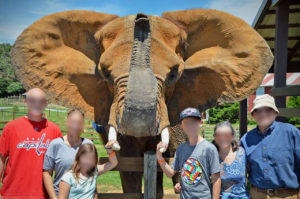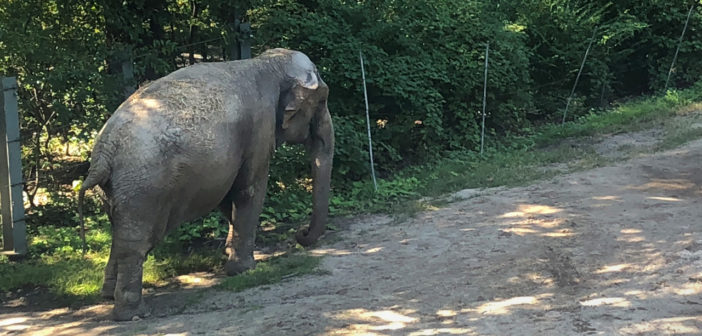Captive elephants are being failed by United States zoos, and their suffering has been exposed by In Defense of Animals in its respected annual list of the 10 Worst Zoos For Elephants in North America, now in its 15th year. The 2018 list reveals outdated, failing, and cruel practices that are harming and killing elephants in U.S. zoos. Bronx Zoo in New York is shamed as the #1 Worst Zoo for keeping two elephants in solitary confinement and failing on its promise to shut down its exhibit following an elephant death in November.

Forced insemination and creating unnatural social groupings is business as usual at Louisville Zoo. Photo credit: In Defense of Animals.
“Elephants are not thriving in constricted zoo exhibits, no matter how fresh the paint or the addition of an acre or two,” said In Defense of Animals President, Marilyn Kroplick M.D. “So-called ‘modern’ zoos continue to use and abuse elephants as property in their relentless pursuit of profits, and the animals always pay the price. Please don’t visit zoos that hold elephants captive.”
Despite changing public opinion and rising concern for the care of captive wild animals, zoos continue the same harmful practices for elephants: Earth’s largest land mammals continue to be captured in the wild and confined in tiny zoo exhibits that cause them to suffer and die prematurely, the use of cruel bullhooks to control elephants through fear and pain is still allowed in most states, and important social bonds are severed when elephants are swapped between zoos like trading cards. So-called “modern” zoos use elephants to attract and entertain customers, some even forcing elephants to perform circus-style tricks under the guise of education. Even the Ringling Bros. and Barnum & Bailey Circus stopped using elephants acts before it shut down entirely.

Wild-caught elephant Asha at Natural Bridge Zoo is forced to give tourist rides and endure heartbreaking solitary confinement. Image credit: Natural Bridge Zoo.
In Defense of Animals’ list of the 10 Worst Zoos for Elephants in North America exposes the serious shortcomings of zoos for elephants. Elephant deaths continue to outpace births due to captivity-caused conditions like obesity, arthritis and foot disease. Still, zoos are spending millions of dollars on renovating or building new exhibits, even though there aren’t enough captive elephants available to fill them.
Many zoos have shut down their elephant exhibits or plan to phase them out. In Defense of Animals is calling for all zoos to do the same.
Dawes said, “Elephants are quickly disappearing from the planet and the captive animal industry is more than willing to deplete wild herds instead of supporting them. Captivity is not conservation and never will be. It’s time for zoos to stop keeping elephants captive to suffer and die, and instead focus on true conservation, which is protecting elephants where they live, in the wild.”
10 Worst Zoos 2018
- Bronx Zoo, Bronx, New York
- Natural Bridge Zoo, Rockbridge County, Virginia
- Dallas Zoo, Dallas, Texas
- Louisville Zoo, Louisville, Kentucky
- Roger Williams Park Zoo, Providence, Rhode Island
- Birmingham Zoo, Birmingham, Alabama
- Caldwell Foundation Zoo, Tyler, Texas
- Topeka Zoo, Topeka, Kansas
- Seneca Park Zoo, Rochester, New York
- Milwaukee County Zoo, Milwaukee, Wisconsin
Discover the full list of the Ten Worst Zoos For Elephants in North America 2018 here.
Featured image: For over a decade, Happy the elephant has lived in forced isolation in a cold, cramped, and utterly outdated enclosure at the Bronx Zoo. Image credit In Defense of Animals.





